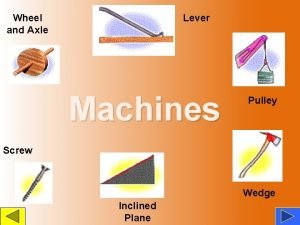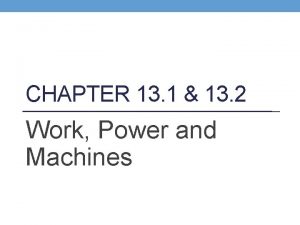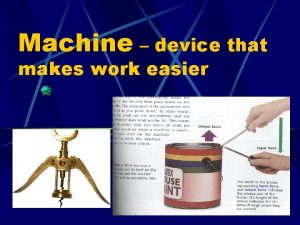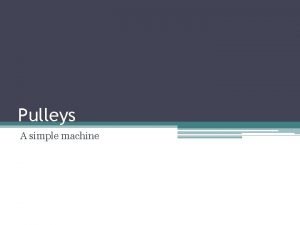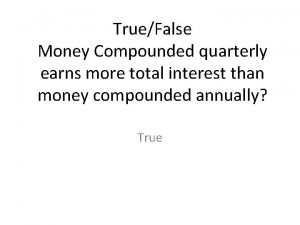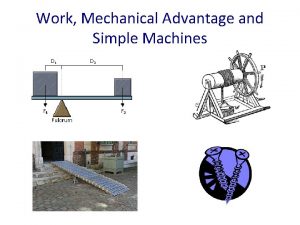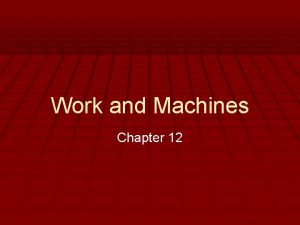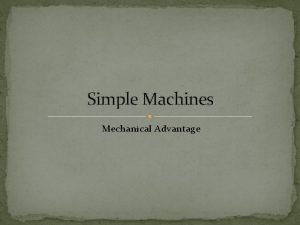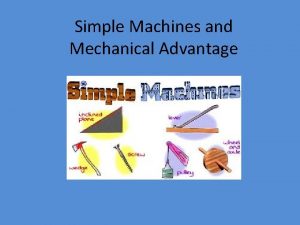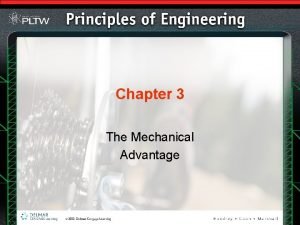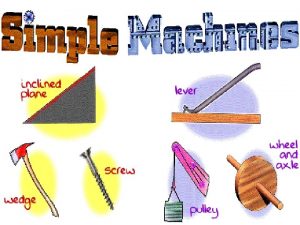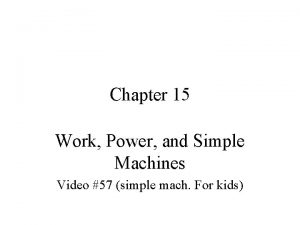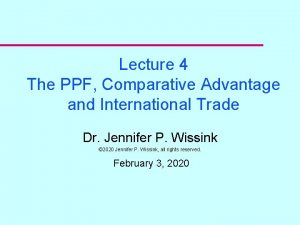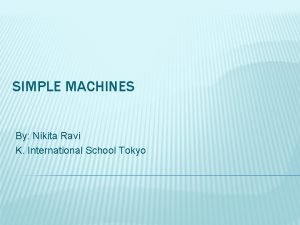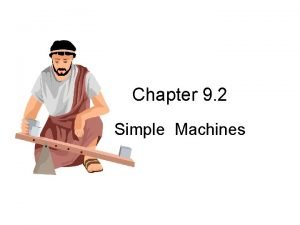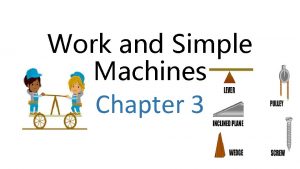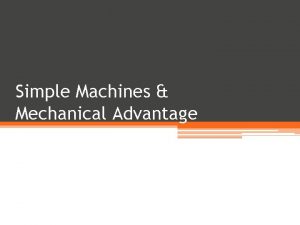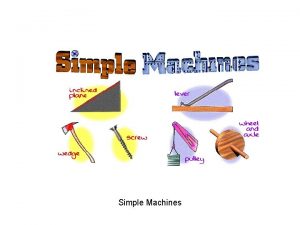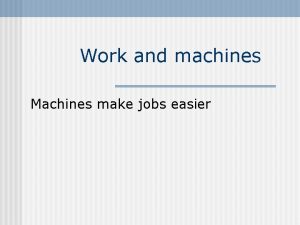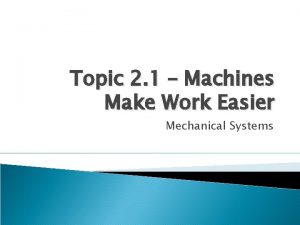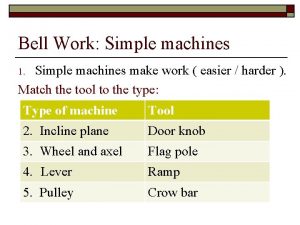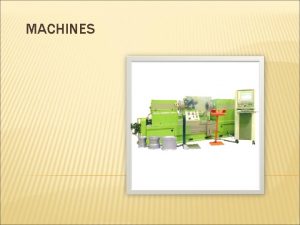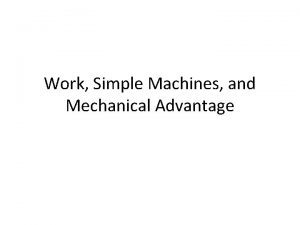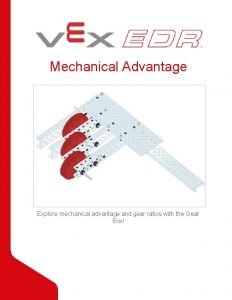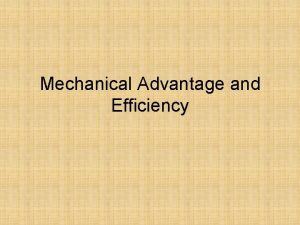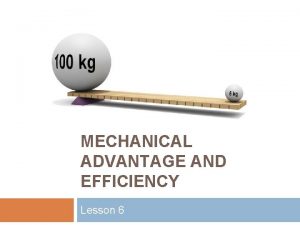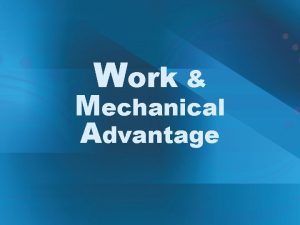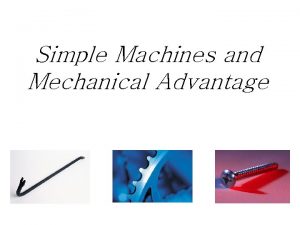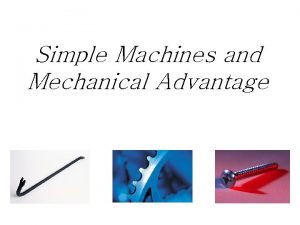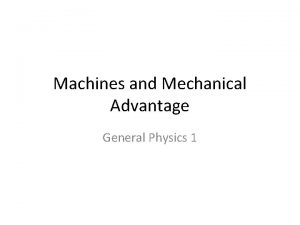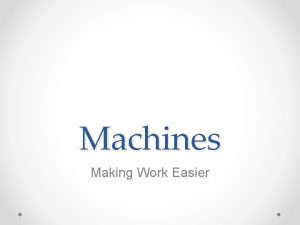Machines make work easier 2 1 Mechanical Advantage























- Slides: 23

Machines make work easier. 2. 1

Mechanical Advantage ¨ - A winding road is actually a series of inclined planes with switchbacks, which allow cars to drive up a steep hill. ¨ Mechanical Advantage – amount by which a machine can multiply a force. (or how much the machine does the work to move an object) – also called the force ratio

Mechanical Advantage Definitions: ¨ Input Force – force applied to the machine. ¨ Output Force – force the machine applies to the object. – Force is measured in Newtons (N). – (1 kg = 9. 81 N of force) Mechanical Advantage= Force output (N) Force Input (N)

Mechanical Advantage ¨ MA > 1 = applied force is bigger than resulting force – Most simple machines work like this ¨ MA = 1 = No advantage (both sides give equal amounts of force) ¨ MA< 1 = resulting force is less than the applied force – Doesn’t necessarily mean the machine is flawed, but serves a different purpose – Ex. Screws have low MA. If if had a high MA, it would

A Mechanical Advantage Less Than 1 ¨ Useful for tasks that do not require a large output force. – Ex) Bicycle – the output force is used for speed. – MA greater than one requires more work • Ex. Pulleys, or pulling a rope has a MA of 2.

¨ 1. Calculate the mechanical advantage for a lever that has the following characteristics: (2 marks) ¨ Input force: 200 N ¨ Output force: 550 N

Mechanical Advantage Questions Bill Nye – Mechanical Advantage

Speed ¨ Speed – measures the distance an object travels in a given amount of time. Speed= Distance (m) Time(s)


¨ 1) Calculate the speed of a person running the 400 m race in 55 seconds

Speed Ratio ¨ Speed Ratio – measure of how the speed of the object is affected by a machine. – SR describes how much faster the user is moving than the load is working (or how much effort you need to put into it to get out of it) SR= Input Distance (m) Output Distance (m)

¨ 1. Calculate the speed ratio for a lever that has the following characteristics: (2 marks) ¨· Input distance: 45 m ¨· Output distance: 15 m

Speed Ratio Questions

Recall ¨ ** A machine can increase or change the direction of the force that you apply. ¨ But, the cost is that the force the user applies must move farther than the load.

The Effect of Friction ¨ Friction – force that opposes motion. ¨ - caused by the roughness of surfaces. ¨ - As roughness of a surface increases so does the effect of friction. ¨ Mechanical Advantage does NOT always equal Speed Ratio. ¨ - Friction can affect MA, but not SR. ¨ - Speed ratio represents the ideal mechanical advantage (No friction).

Efficiency ¨ - Friction creates HEAT, and must be released to protect the system. ¨ ¨ Efficiency – measurement of how well a machine or device uses energy. – affected by friction. – most energy lost is unusable (ex. Heat).

Efficiency= MA SR OR Output Energy Input Energy Most complex machines are very inefficient: waste energy. – Ex) Car – 15% efficient.

¨ 1. Calculate the efficiency for a lever that has the following characteristics: (4 marks) ¨· Input distance: 45 m ¨· Output distance: 15 m ¨· Input force: 200 N • Output force: 550 N

¨ MA= Output force/Input force – =550 N/200 N – = 2. 75 ¨ SR= Input distance/Output distance – = 45 m/15 m – =3 ¨ E= MA/SR – = 2. 75/3 – =0. 9166 – =91. 7%

¨ Efficiency Questions

Formulas to know thus far: MA= Output force/Input force S=Distance/Time (m/s) SR= Input distance/ output distance Efficiency= MA/SR

¨ http: //ca. youtube. com/watch? v=yf. Adm. RJD KIc ¨ http: //streaming. discoveryeducation. com/se arch/asset. Detail. cfm? guid. Asset. ID=23 EED D 1 A-DF 79 -4 A 21 -A 4 BA-792 C 328 A 039 B

Homework! ¨ C & R p. 286 ¨ 2 -5 ¨ Practice Questions
 How do machines make work easier
How do machines make work easier Actual mechanical advantage vs ideal mechanical advantage
Actual mechanical advantage vs ideal mechanical advantage Lever inclined plane wheel and axle
Lever inclined plane wheel and axle Types of pulleys simple machines
Types of pulleys simple machines How does a wedge make work easier
How does a wedge make work easier What is a device that makes work easier
What is a device that makes work easier Difference between movable pulley and fixed pulley
Difference between movable pulley and fixed pulley Geography of sw asia color by number
Geography of sw asia color by number Credit unions are for-profit organizations. true false
Credit unions are for-profit organizations. true false Mechanical machine
Mechanical machine How does mechanical advantage work
How does mechanical advantage work The ratio of resistance force to effort force
The ratio of resistance force to effort force Advantages of simple machines
Advantages of simple machines How does mechanical advantage work
How does mechanical advantage work A device that makes doing work easier
A device that makes doing work easier Effforce
Effforce Making work easier
Making work easier Chapter 4 section 1 work and machines answer key
Chapter 4 section 1 work and machines answer key Mechanical drives and lifting machines n2
Mechanical drives and lifting machines n2 Ppf
Ppf Stapler is which type of simple machine
Stapler is which type of simple machine Simple machines made up of two inclined planes
Simple machines made up of two inclined planes Two wheels of different sizes that rotate together
Two wheels of different sizes that rotate together Ma 6
Ma 6


